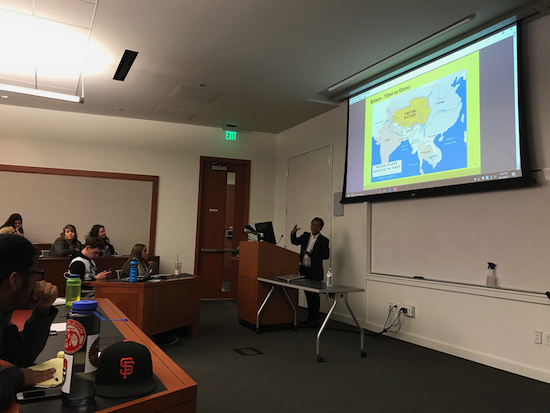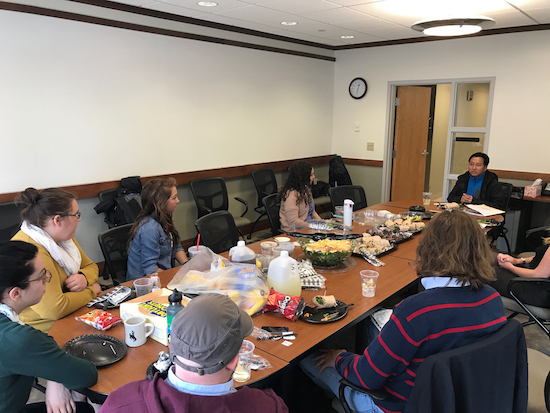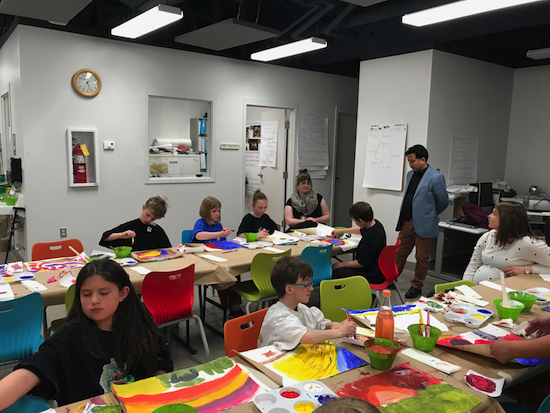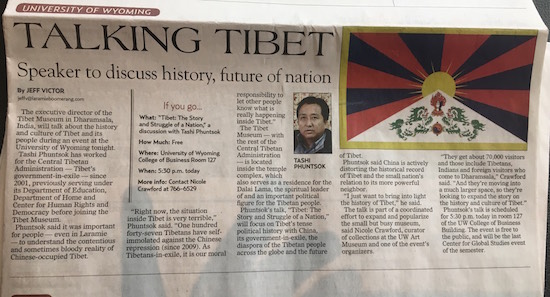University of Wyoming Hosts Talk on History of Tibet
[Source:tibet.net]

Mr Tashi Phuntsok, Director of Tibet Museum, speaking at the University of Wyoming.
WYOMING, US: Mr. Tashi Phuntsok, Director of the Tibet Museum of the Department of Information and International Relations, Central Tibetan Administration, spoke on the history of Tibet during an event at the University of Wyoming, United States, on April 25, 2017.
His public presentation was primarily focused on correcting the historical narrative that exists in China by demonstrating the long-term independent status of Tibet within its borders and in relation to the global diplomatic community. The talk was wonderfully illustrated with a helpful timeline and images of important archival materials that demonstrate the long history of Tibetan sovereignty.
Mr. Phuntsok’s lecture was extremely well attended with 66 people packed into a room with an official capacity for 60. Significantly, attendees included faculty, students, and a large number of Laramie community members who engaged in a robust Q&A at the conclusion of his presentation. His talk was profiled in the local newspaper, the Laramie Boomerang.
After the talk, Mr. Phuntsok had the opportunity to talk in some depth with Mark Jenkins, a prominent reporter for National Geographic who has extensive travel experience in Tibet and who is also a writer-in-residence at UW.
Mr. Tashi Phuntsok was invited by the Center for Global Area Studies and the University of Wyoming Art Museum, to give a public presentation on the history of Tibet and consult on the renovation of the Tibet Museum with Nicole Crawford, Curator of Collections, UW Art Museum and Isadora Helfgott, Associate Professor, History and Curator of Academic Engagement, UW Art Museum. While in Laramie, Mr. Phuntsok met with faculty, students, museum and archives staff, community members and local artists. His visit resulted in substantial progress on the Tibet Museum Case Statement, extensive information gathering as to UW practices in museum and archive management, exhibition development and installation techniques. It also resulted in robust conversations across campus and in the community about the history and culture of Tibet and the experiences of Tibetans in exile.
At the UW Art Museum, Mr. Phuntsok had the opportunity to meet with staff across a variety of areas of expertise, including curatorial, education, exhibition preparation and installation, collections management and community engagement. He also had the opportunity to talk about administrative matters with the Director of the UW Art Museum. He observed a school group visit to the museum led by the Master Teacher and met with the Chief Preparator to discuss questions of installation strategy, building materials and lighting. He also had the opportunity to meet with the Registrar and Collections Manager to discuss collections care procedures and to take a behind-the-scenes tour of UAM storage facilities. At the American Heritage Center, Mr. Phuntsok met with the Collection Manager and discussed storage and preservation practices for both archival and photographic material as well as digitization initiatives.
Mr. Phuntsok also had an opportunity to tour the Legacy Hall at the UW Gateway Center. The exhibition in this facility makes innovative use of technology in order to present both a clean and accessible overview of the history of the university with digital access that enables visitors to go into greater depth in terms of archival and photographic materials within each topic area. Finally, Mr. Phuntsok met with the Director of the Center for Global Studies (CGS), which sponsored his visit to UW. They discussed the scope of UW’s internationalization efforts and its interdisciplinary emphasis including faculty in Environment and Natural Resources.
Mr. Phuntsok also consulted with members of the community. He met with a local psychology expert who has extensive experience training teachers in a Tibetan school in India and who has been instrumental in fostering a community in Laramie with interest in Tibetan culture and politics. His meeting with the head of the local artists’ coalition focused on museum/community partnerships that engage artists and other community members in hands-on, project-based initiatives as well as civic improvement projects such as the Laramie Mural Project. They brainstormed possibilities for increasing visibility of the Museum in the community, including age-inclusive art projects based on permanent and temporary exhibitions at the Museum, artists in residence, and using new technology such as dynamic projections in public spaces.
Lastly, Mr. Phuntsok met with two groups of students on campus. First, he gave a presentation on his own personal and professional background and the redevelopment of the Tibet Museum to Global Studies graduate students and then engaged them in conversation about some of the complex contemporary issues facing Tibet in its relations with China. Second, he met with a group of current and former Museum Studies students who have previously been involved in a research capacity with international museum development projects. They presented their work on researching artifact looted from Cambodia during the Khmer Rouge period as an example of how UW students might be engaged in substantive projects in support of the Tibet Museum’s redevelopment project and larger outreach goals.
Report filed by:
Isadora Helfgott and Nicole Crawford
The University of Wyoming

Mr Tashi Phuntsok holding discussion with students from global area studies.

Mr Tashi Phuntsok inspecting an educational activity.

local newspaper, the Laramie Boomerang.
